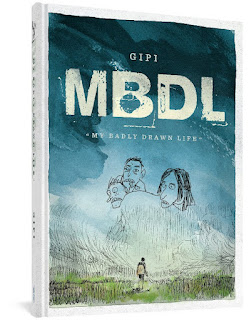Time Under Tension by M.S. Harkness
How do any of us choose the next book to read? Looking at a big list of possibilities – all things you don’t know well, all things new and different – what sparks the thought “that one”?
This time, it was hair.
On the cover of Time Under Tension , her major 2023 graphic memoir, creator M.S. Harkness draws her hair as a giant, swoopy, structural thing – almost a separate, solid object, like a shark’s fin. That said to me “this is a creator who is comfortable with caricature, who gets that cartooning is how to put complicated ideas down on the page. She’s going to be interesting to read on a craft and structure level.”
I don’t want to say “I was right.” Let’s say I accurately noticed some clear strengths in Harkness’s immediate, uncompromising work. Let’s say that she both has the drawing and page-layout chops to tell a difficult story well, and both the material in her own life and the mental strength to turn that into art to work from. Let’s say I was not disappointed.
This is autobiographical: I assume it’s true as much as any memoir is, that some characters may be somewhat fictionalized or events moved in time or dialogue reconstructed to work better on the page. It feels real. Harkness has an immediacy, in her bold lines and her in-your-face storytelling, that tells the reader she is not fucking around here.
We open just before her art-school graduation, in what turns out to be an extended prologue that jumps back and forth in time during that taut moment of almost that is the month before that big day. All of the work is done; the group show is being hung. Harkness knows she will graduate. There’s a moment where a teacher bluntly tells her “I had to keep everyone else from failing. I was never really worried about you. Your art career or whatever…you’ll be fine.”
This section sets up the tensions and issues Harkness will be working through during the bulk of the book, rolling out over most of the next year.
And, no matter what that art professor thought, she is not fine.
She’s organized, focused, driven. She has a plan and multiple goals. She’s working on her first graphic novel and studying to become a personal trainer. She has a sympathetic fellow-artist roommate as a support system, and is plugged into the larger comics world.
She’s also doing random one-off sex-work jobs to plug holes in her budget. The book description says she’s also selling weed for the same purpose, but we really don’t see that in the story. She has a messy relationship with an up-and-coming MMA fighter – she is, or was, his dealer, and a fuck-buddy for this guy who already has a “girlfriend.” She wants to be more to him than he’s willing to give, and he keeps coming back but is at least honest about what’s going on.
Behind all that is a horrible childhood: a sexually abusive father about to get out of prison and reaching out through some kind of reparations program to make an “apology” she wants nothing to do with. A mother who means well but who Harkness sees as weak and doesn’t have much in common with.
I don’t want to psychoanalyze her, especially based on her own presentation. But there’s clearly trauma there that she’s still trying to get away from, and a complex nexus of physicality: working out herself, helping other people’s bodies get strong as a trainer, the random paid sex, the toll on arms and back from hunching over a drawing board. Time Under Tension isn’t really about all of those physical demands on her body, and how they intersect with each other, but I wouldn’t be surprised if her next book was – or the book after that.
Harkness seeks out therapists, which doesn’t go well. She knows she’s driven and goal-focused, but feels like she’s not connecting with people: they’re all just roles in this march forward, each one just a piece of one of her projects.
She has to work it out herself, the same way she does everything. More work, more pushing forward, one day at a time.
In the way of comics, it may be telling the story of a few years ago: I see that Harkness is now thirty-one. Time Under Tension was Harkness’s third book; the first two were also comics memoirs. She’s said that she intends to do five books in this “series.” But this one stands alone: it tells a full story brilliantly, with an unblinking eye on her own life and problems.
And her hair is magnificent. Harkness has a stark style with strategically deployed spots of black, and her hair is the most consistent large black element on most of these pages, drawing the eye to its complexity and unruliness. I wonder if we will see that hair settle down in future books, as Harkness moves forward in life and gets her demons more under control. I hope so. I’d love to see it.
Reposted from The Antick Musings of G.B.H. Hornswoggler, Gent.





















